Array Indices Must Be Positive Integers Or Logical Values
In programming, arrays are widely used to store and organize collections of data. Array indices play a crucial role in accessing and manipulating elements within an array. However, it is important to understand that array indices must be positive integers or logical values, as anything else would result in errors and unexpected behavior.
Valid Array Indices:
The most common and accepted form of array indices are positive integers. These positive integers represent the position of an element within an array. The index values start from 1 and increment by 1 for each subsequent element.
Here’s an example to illustrate valid array indices using positive integers:
array = [10, 20, 30, 40, 50]
Index: 1 2 3 4 5
Accessing Arrays Using Positive Integers:
To access elements within an array using positive integers, you simply provide the respective index value within square brackets. For example, to access the second element in the above array, you would write:
array[2] => 20
Logical Values as Array Indices:
In some programming languages, it is also possible to use logical values as array indices. Logical values, such as “true” or “false”, can be used to access elements within an array based on certain conditions or criteria.
When and How to Use Logical Values as Array Indices:
Logical values as array indices are particularly useful when you want to selectively access elements based on specific conditions. For example, consider an array of student names and their corresponding grades. Using a logical value as an array index, you can retrieve the names of students who scored above a certain threshold.
Benefits and Limitations of Using Logical Values as Array Indices:
The use of logical values as array indices adds flexibility and allows for dynamic access to array elements. It enables you to create conditional checks and extract elements based on customized criteria. However, it must be noted that not all programming languages support logical values as array indices. Moreover, using logical values can increase the complexity of code and require careful handling to avoid errors.
Examples of Using Positive Integers and Logical Values as Array Indices:
Let’s consider two examples to demonstrate the use of both positive integers and logical values as array indices.
Example 1: Accessing an array element using a positive integer index:
array = [10, 20, 30, 40, 50]
index = 3
Accessing the element at index 3:
array[index] => 30
Example 2: Accessing an array element using a logical value index:
array = [12, 45, 34, 27, 59]
boolean_array = [true, false, true, true, false]
Accessing elements with logical value “true”:
array[boolean_array] => [12, 34, 27]
FAQs (Frequently Asked Questions):
Q1: What happens if I use a negative integer or a non-integer as an array index?
A1: Using a negative integer or a non-integer as an array index will result in an error, as it violates the requirement of using positive integers or logical values.
Q2: Can I use floating-point numbers as array indices?
A2: Most programming languages do not allow the use of floating-point numbers as array indices. They require indices to be positive integers or logical values.
Q3: What are the possible errors I may encounter regarding array indices?
A3: Some common errors include “Index in position 2 is invalid array indices must be positive integers or logical values,” “Index exceeds the number of array elements index must not exceed 1,” and “Operands to the || and && operators must be convertible to logical scalar values, array indices must be positive integers or logical values.”
Q4: Can I modify array indices dynamically during program execution?
A4: Array indices are typically static and fixed during program execution. However, logical values can be used to create dynamic indices based on specific conditions.
In conclusion, array indices must be positive integers or logical values to ensure correct access and manipulation of array elements. By understanding the valid array indices and utilizing them appropriately, programmers can enhance the efficiency and reliability of their code.
Trying To Fix A Problem In A Matlab Code (Array Indices Must Be Positive Integers Or Logical Values)
What Is Array Indices Must Be Positive Integers Or Logical Values?
In computer programming, arrays are a fundamental data structure used to store multiple values of the same data type. Each value in an array is assigned an index, which is used to access or modify specific elements within the array. However, it is crucial to understand that array indices must be positive integers or logical values. This article will delve into the reasons behind this requirement, its significance, and how it relates to programming languages. We will also address commonly asked questions regarding this topic.
Array indices serve a crucial role in computer programming. They are used to identify the position of each element within an array. By specifying a particular index, programmers can access or modify the value of a desired element. It is important to note that array indices usually start at zero, which means the first element in an array is assigned an index of zero, the second element has an index of one, and so on.
The requirement for array indices to be positive integers or logical values is primarily driven by the need for efficient memory management and controlled access to array elements. Programming languages utilize the underlying memory structure to store arrays, ensuring optimal usage of computer resources. By enforcing the use of positive integers or logical values as indices, languages can establish a standardized and secure method for accessing array elements.
Several reasons can explain why only positive integers or logical values are permitted as array indices. First and foremost, it helps prevent memory-related errors. Arrays are stored in contiguous memory locations, and accessing an element outside the bounds of the array can result in memory corruption or unpredictable behavior. Therefore, limiting array indices to positive values eliminates the possibility of accessing invalid memory addresses and ensures the stability of the program.
Another reason behind this requirement is to maintain consistency and compatibility across different programming languages. While programming languages may differ in syntax and features, they often share common principles and practices. Using positive integers or logical values as array indices is a standard convention followed by most programming languages. This consistency allows programmers to easily switch between different languages without needing to relearn the fundamentals.
Furthermore, by restricting the array indices to positive integers, programming languages simplify error handling and improve code readability. Using negative indices or non-integer values as array indices can make code more complex and prone to errors. By adhering to positive integers, such as zero-based indexing, programmers can write clean and concise code, enhancing the overall quality and maintainability of their programs.
FAQs:
Q: Can I use floating-point numbers or negative integers as array indices?
A: No, the requirement for array indices to be positive integers or logical values is standard across most programming languages. Using floating-point numbers or negative integers is generally not allowed. However, some programming languages provide alternative data structures, such as dictionaries or associative arrays, which allow non-integer keys.
Q: What happens if I try to access an array element using an invalid index?
A: Accessing an array element using an invalid index can result in runtime errors or undefined behavior. The specific consequences may vary depending on the programming language and the runtime environment. In some cases, it may throw an exception, crash the program, or produce unexpected results.
Q: Why is zero-based indexing used in many programming languages?
A: Zero-based indexing is a common practice in programming languages as it aligns well with the underlying memory representation of arrays. It simplifies pointer arithmetic and memory calculations, making it a more efficient choice in terms of resource usage. Additionally, zero-based indexing promotes mathematical consistency and reduces off-by-one error pitfalls.
Q: Are there any exceptions to the rule of using positive integers as array indices?
A: Some specialized data structures or programming languages may allow exceptions to this rule. For example, in certain cases, a language may permit the use of negative indices for arrays, with the understanding that they represent offsets from the end of the array. However, such cases are relatively rare and are not generally recommended due to the potential for confusion and error.
In conclusion, understanding that array indices must be positive integers or logical values is essential for programming. This requirement ensures memory safety, promotes consistency across programming languages, and simplifies code readability. By adhering to this rule, programmers can write robust and reliable programs while enjoying the benefits of a standardized programming practice.
What Is Array Indices In Matlab?
Array indices form a critical aspect of MATLAB, allowing users to access and manipulate individual elements of an array. Understanding how array indexing works is crucial for efficient programming in MATLAB. In this article, we will delve into the concept of array indices, explore their different applications, and address some frequently asked questions.
Understanding Array Indices:
In MATLAB, an array is a collection of elements stored in a specific order. Arrays can be one-dimensional, two-dimensional (matrices), or multi-dimensional. Each array element is assigned a unique index, indicating its position within the array.
Array indices begin at 1 in MATLAB, unlike many programming languages where they usually start at 0. This indexing convention aligns MATLAB with mathematical notation, making it intuitive for mathematicians and scientists to work with arrays.
Array Indices: Applications and Examples
Array indices are widely used in MATLAB for various purposes, including accessing individual elements, slicing arrays, and assigning new values.
1. Accessing Individual Elements:
To access a specific element of an array, you can use its corresponding index. For example, consider a 1D array named “A” consisting of five elements. To access the third element, you can write “A(3)”.
2. Slicing Arrays:
Array indexing also allows you to extract a subset of elements from an array, known as slicing. This is particularly useful when dealing with large arrays or matrices. To slice an array, you can specify a range of indices enclosed within square brackets, such as “A(2:4)”.
3. Modifying Array Elements:
Array indices facilitate modifying the values of specific elements within an array. By assigning a new value to an indexed element, you can update its content. For instance, if “A” represents a 1D array, the code “A(2) = 7” will change the value of the second element of “A” to 7.
4. Logical Indexing:
MATLAB offers a powerful feature called logical indexing. It allows you to index array elements based on a logical condition instead of explicitly specifying indices. For instance, if “B” is an array, “B(B>5)” will return a new array consisting of all elements greater than 5 in “B”. This feature is particularly useful in data filtering and manipulation.
5. Multi-dimensional Arrays:
Array indexing can be extended to multi-dimensional arrays, commonly known as matrices. In such cases, indices are specified using row and column subscripts. For instance, for a matrix “M,” “M(2,3)” represents the element at the second row and third column. Similarly, slicing can be performed along both dimensions, such as “M(2:4, 1:3)”.
FAQs about Array Indices in MATLAB:
Q1. Can array indices be negative in MATLAB?
No, MATLAB does not support negative array indices. You must use positive integers to access array elements.
Q2. Can I use non-integer indices in MATLAB?
No, array indices in MATLAB must be integers. Non-integer values or expressions will result in an error.
Q3. What happens if I exceed the array dimensions using indices?
If you try to access an element beyond the array dimensions, MATLAB will generate an “Index out of bounds” error. It is essential to ensure that the indices used are within the valid range of the array.
Q4. Can array indices be variables or expressions?
Yes, you can use variables or expressions as array indices. However, you need to ensure that they evaluate to valid integer values representing a valid position within the array.
Q5. Can I use array indices to access elements in nested arrays?
Yes, MATLAB supports indexing nested arrays, allowing you to access individual elements in multi-dimensional arrays or cell arrays. You would need to specify the indices for each level of nesting.
Q6. Is array indexing limited to numerical arrays?
No, array indices can be used with various data types, including numerical, logical, character, and cell arrays. The indexing behavior may vary depending on the specific data type.
Conclusion:
Array indices play a fundamental role in MATLAB programming, enabling efficient access and manipulation of array elements. By understanding how to use indices, you can harness the full potential of MATLAB for various applications. Whether it is extracting specific data, modifying elements, or performing complex slicing operations, array indexing is a powerful tool in MATLAB’s arsenal. Familiarity with array indices will undoubtedly enhance your MATLAB programming skills and productivity.
Keywords searched by users: array indices must be positive integers or logical values Index in position 2 is invalid array indices must be positive integers or logical values, Array indices must be positive integers or logical values, Array indices must be positive integers or logical values MATLAB for loop, Index in position 1 is invalid array indices must be positive integers or logical values, array indices matlab, Index exceeds the number of array elements index must not exceed 1, matlab logical values, Operands to the || and && operators must be convertible to logical scalar values
Categories: Top 100 Array Indices Must Be Positive Integers Or Logical Values
See more here: nhanvietluanvan.com
Index In Position 2 Is Invalid Array Indices Must Be Positive Integers Or Logical Values
When working with arrays in programming, it is essential to understand how indices function. An index refers to the position or location of an element within an array. It helps access or manipulate specific elements effectively. However, at times, you may encounter an error stating “Index in position 2 is invalid: array indices must be positive integers or logical values.” This article will delve into the meaning of this error message, its possible causes, and potential solutions. By the end, you should have a clear understanding of this error and how to handle it.
What does the error message mean?
The error message “Index in position 2 is invalid: array indices must be positive integers or logical values” indicates an issue with the index value used to access an element within an array. In most programming languages, array indices start from 0, meaning that the first element is accessed using index 0, the second using index 1, and so on. Thus, this error suggests that the index value used is either a negative integer, zero, or a non-integer data type.
Causes of the error
1. Negative index value: Arrays do not accept negative indices. Trying to access an element with a negative index will result in an “invalid index” error. For example, attempting to access array_name[-1] would produce this error message.
2. Zero as an index value: Arrays typically begin with index 0 and continue sequentially. Using 0 as an index value is valid, but if the index value is accidentally set as 0 or if the array is empty, it could lead to the reported error.
3. Non-integer value as an index: Arrays generally accept only positive integers as indices. Attempting to access an array element using a non-integer or non-logical value would trigger the error. For instance, if array_name[0.5] or array_name[“index”] were used, this error would appear.
Solutions and troubleshooting
1. Review and adjust the index value: Double-check the index value used in your code. Ensure it is positive, corresponds to a valid array element, and is an integer or logical value. Remember that indices start from 0 and continue sequentially.
2. Ensure the array is not empty: Verify that the array being accessed contains elements. If the array is empty, any index value will be considered invalid. Consider initializing the array with values or ensuring it is correctly populated before accessing specific elements.
3. Verify the nature of the index variable: If you are using a variable as the index, ensure that it contains a positive integer or logical value. Use appropriate type casting or checks to ensure the variable holds a valid index value.
4. Check for off-by-one errors: It is common to accidentally use an incorrect index value due to a miscalculation or oversight. Review your code for any off-by-one errors, especially when iterating over arrays or manipulating index values within loops.
5. Debugging and error messages: Utilize debugging tools or error messages offered by your programming environment. These tools can help pinpoint the exact location of the error, allowing for more efficient troubleshooting.
FAQs
Q: Can an array index in programming be a negative number?
A: No, array indices in most programming languages cannot be negative. They start from 0 and proceed sequentially as positive integers.
Q: Can I use zero as an index value for an array?
A: Yes, in most programming languages, arrays begin at index 0, so using 0 as an index value is valid. However, if the array is empty, setting 0 as the index will result in an “invalid index” error.
Q: Is it possible to use a non-integer index value for an array?
A: No, array indices must be positive integers or logical values. Non-integer values, such as floating-point numbers or character strings, will result in an “invalid index” error.
Q: Are there programming languages that allow non-integer or negative indices?
A: Yes, some programming languages, such as MATLAB, support non-integer indices or indexing from negative values. However, it is important to consult the specific language documentation before using such features.
Q: How can I identify the source of this error?
A: Debugging tools and error messages provided by your programming environment can assist in identifying the exact location of the error. These tools help trace the execution flow and highlight the problematic line of code.
Conclusion
Understanding how array indices work in programming is crucial for efficient code development. The error message “Index in position 2 is invalid: array indices must be positive integers or logical values” indicates an issue with the index value used to access elements. By ensuring index values are positive, starting from 0, and are valid integer or logical values, you can effectively handle this error. By applying troubleshooting techniques and carefully reviewing your code, you will overcome such errors and enhance your programming skills.
Array Indices Must Be Positive Integers Or Logical Values
To understand the significance of this rule, we must first understand what an array index is. An array index refers to the position of an element within an array. It allows us to access and manipulate the values stored in a specific location of the array. Array indices are typically represented using non-negative integers, starting from zero for the first element and incrementing by one for each subsequent element. This standard convention is widely used across various programming languages.
The requirement of positive integers or logical values as array indices serves several purposes. Firstly, it enforces a consistent and predictable structure for arrays. By adhering to this rule, we can ensure that each element is uniquely identified and can be accessed without ambiguity. This predictability makes the code more readable and maintainable, as developers can easily understand and follow the logic of the program.
Secondly, enforcing positive integers or logical values as array indices can prevent potential runtime errors. Imagine if negative integers or non-logical values were allowed as array indices. This would introduce ambiguity and make it difficult to determine the intended location within the array. As a result, accessing or manipulating array elements could lead to unpredictable behavior, often causing runtime errors like segmentation faults or memory corruption. By restricting indices to positive integers or logical values, we can reduce the likelihood of such errors and improve the overall stability of the program.
Furthermore, requiring positive integers or logical values as array indices helps optimize memory allocation. When an array is declared, the compiler or interpreter allocates a contiguous block of memory to store the elements. This memory block is divided into fixed-size slots, with each slot corresponding to an array element. By using non-negative integers for indices, we ensure a predictable mapping between the indices and memory slots, allowing for efficient memory access and retrieval operations.
Now, let’s address some frequently asked questions related to array indices:
Q: Can array indices be floating-point numbers or characters instead of positive integers or logical values?
A: No, array indices cannot be floating-point numbers or characters. Floating-point numbers are continuous and, therefore, not suitable for discrete indexing purposes. Similarly, characters are usually used to represent individual characters within strings or arrays, rather than being used as direct indices. The requirement of positive integers or logical values ensures the integrity and predictability of array indexing.
Q: What happens if I use a negative number as an array index?
A: Using a negative number as an array index is typically considered an invalid operation and can result in unpredictable behavior. In most programming languages, accessing array elements with negative indices will either throw an exception or, in some cases, compile but yield unexpected results. It is important to avoid using negative numbers as array indices to ensure the correctness and stability of your code.
Q: Can I use zero as an array index?
A: Yes, zero can and should be used as an array index. In most programming languages, array indices start from zero, with the first element at index zero, the second at index one, and so on. This convention is important to ensure consistent indexing throughout the codebase and allow for proper memory allocation and retrieval.
Q: Are logical values like true and false commonly used as array indices?
A: No, logical values like true and false are not commonly used as array indices. Array indices are primarily intended to be non-negative integers. While logical values can be used in various programming constructs, using them as array indices can lead to confusion and hinder the readability of the code.
In conclusion, array indices must be positive integers or logical values to ensure a predictable, error-free, and memory-optimized approach to working with arrays. By adhering to this rule, developers can efficiently access and manipulate array elements while maintaining code integrity. Understanding and following this fundamental principle is essential for writing reliable and efficient code in any programming language.
Array Indices Must Be Positive Integers Or Logical Values Matlab For Loop
When working with arrays, whether they are matrices, vectors, or multidimensional arrays, indexing is a fundamental operation. It allows us to access and manipulate individual elements or subsets of elements within an array. MATLAB follows a one-based indexing system, meaning that the first element in an array has an index of 1.
The for loop is widely used in MATLAB to iterate over arrays and perform repetitive tasks. It provides an efficient and convenient way to access and modify array elements. However, for the loop to work as expected, the indices used within it must meet the requirements set by MATLAB.
One of the primary requirements is that array indices must be positive integers. Negative indices or non-integer values will result in an error. This limitation is imposed to maintain consistency within the MATLAB language and ensure that indexing operations remain well-defined. In mathematical notation and computer science conventions, array indices are typically represented using positive integers.
Using negative indices could lead to ambiguous interpretations and unexpected behavior. For example, if negative indices were allowed, -1 could be interpreted as the last element of the array, -2 as the second-to-last element, and so on. This could create confusion and make the code less readable and maintainable. By restricting indices to positive integers, MATLAB provides a straightforward and standardized method for indexing arrays.
Logical values, specifically true and false, can also be used as indices in MATLAB for loops. When a logical index is used, MATLAB selects the elements of the array corresponding to true values and ignores the ones corresponding to false values. This provides a powerful way to subset arrays based on certain conditions. For instance, we can use a logical index to extract all the elements that satisfy a given criterion or to modify only specific elements within an array.
Now, let’s address some common questions related to array indices in for loops:
Q: Can I use floating-point numbers as indices in a for loop?
A: No, MATLAB only accepts positive integers or logical values as indices. Floating-point numbers will result in an error.
Q: What happens if I try to access an array element using an index greater than its size?
A: MATLAB will throw an “Array indices must be positive integers or logical values” error, indicating that the index is out of bounds. It is important to ensure that the indices used within a for loop do not exceed the size of the array.
Q: Can I use negative indices if I convert the array to a cell array or structure?
A: No, the restriction on negative indices applies to all types of arrays in MATLAB. Converting the array to a cell array or structure does not change this limitation.
Q: Is it possible to use character array indices instead of positive integers in for loops?
A: No, MATLAB does not support character array indices. The indices must be positive integers or logical values.
Q: Can I modify the values of an array element directly within a for loop?
A: Yes, you can modify the values of an array element using its index within a for loop. However, it is important to exercise caution and ensure that the index is within the valid range of the array to prevent out-of-bounds errors.
In conclusion, understanding the requirements for array indices in MATLAB for loops is essential for writing error-free and efficient code. By restricting indices to positive integers or logical values, MATLAB ensures consistency, readability, and predictability within the language. Keeping these guidelines in mind will help you write robust and reliable code when working with arrays in MATLAB.
Images related to the topic array indices must be positive integers or logical values

Found 35 images related to array indices must be positive integers or logical values theme


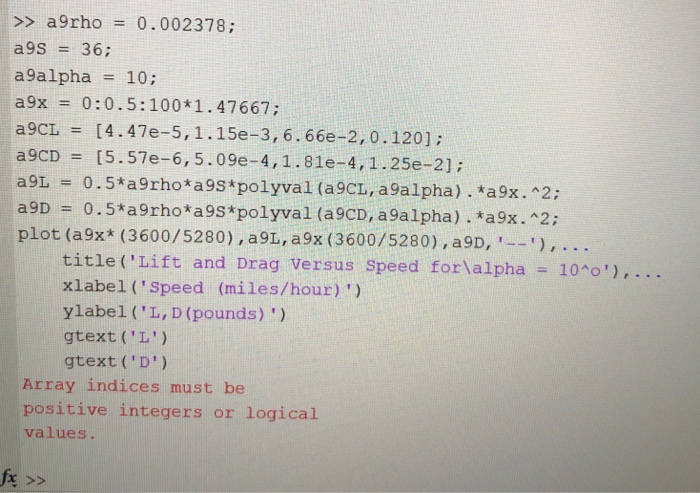



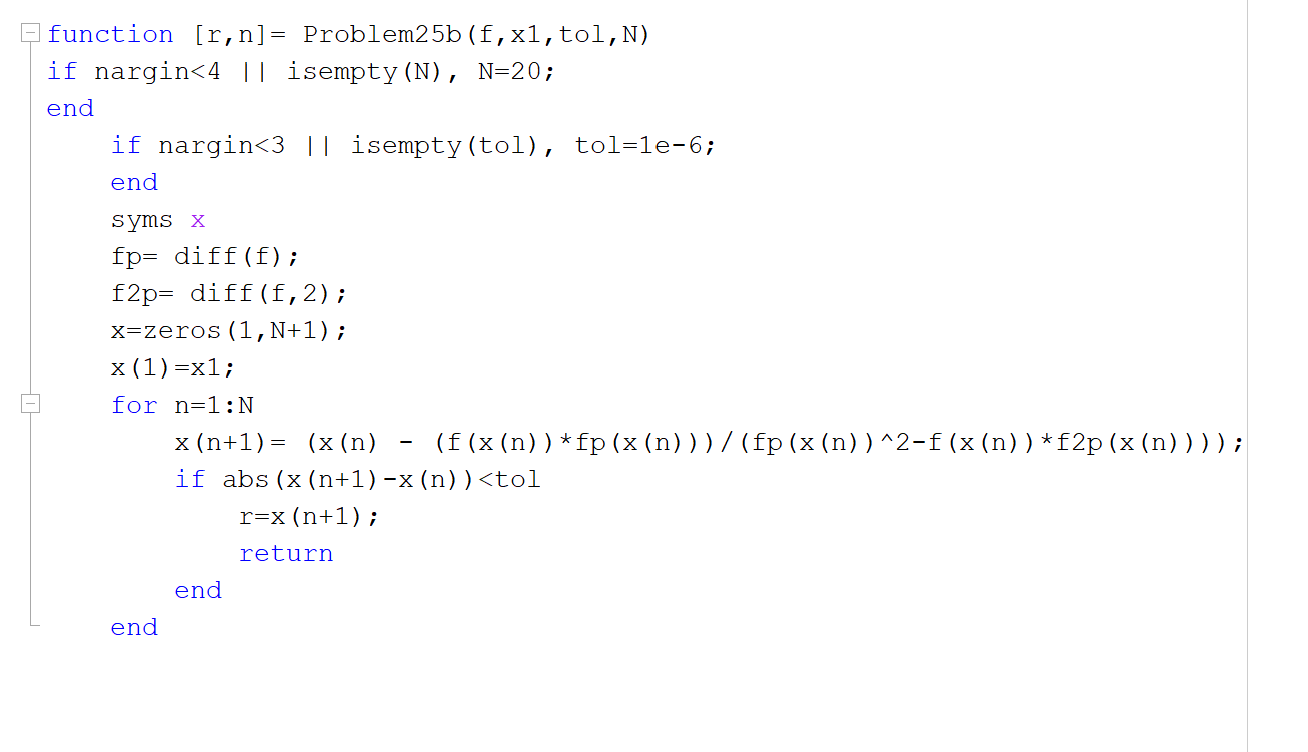


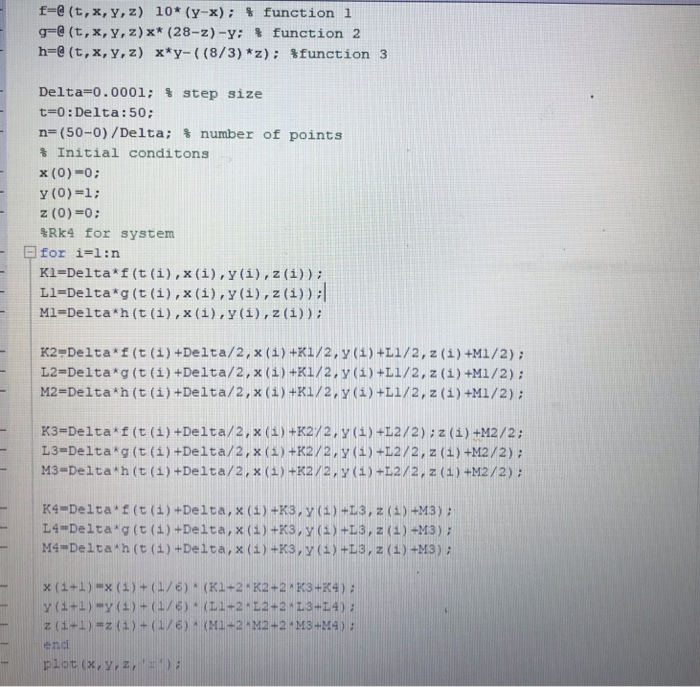




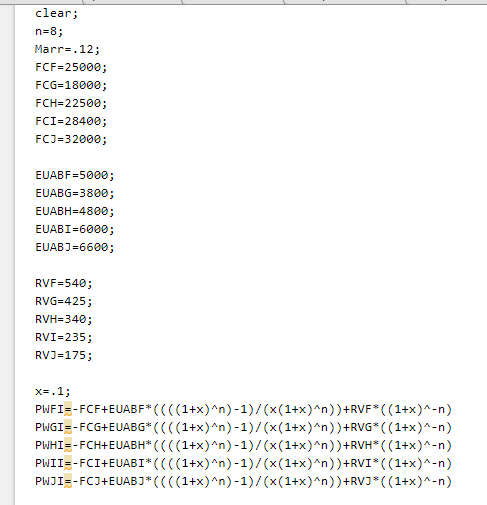

![Solved function [] = turtleGraph (cond) floor= char (zeros | Chegg.com Solved Function [] = Turtlegraph (Cond) Floor= Char (Zeros | Chegg.Com](https://media.cheggcdn.com/media/9f3/9f35737f-daf6-4ac5-b80d-3adad822964e/php2X0P68)
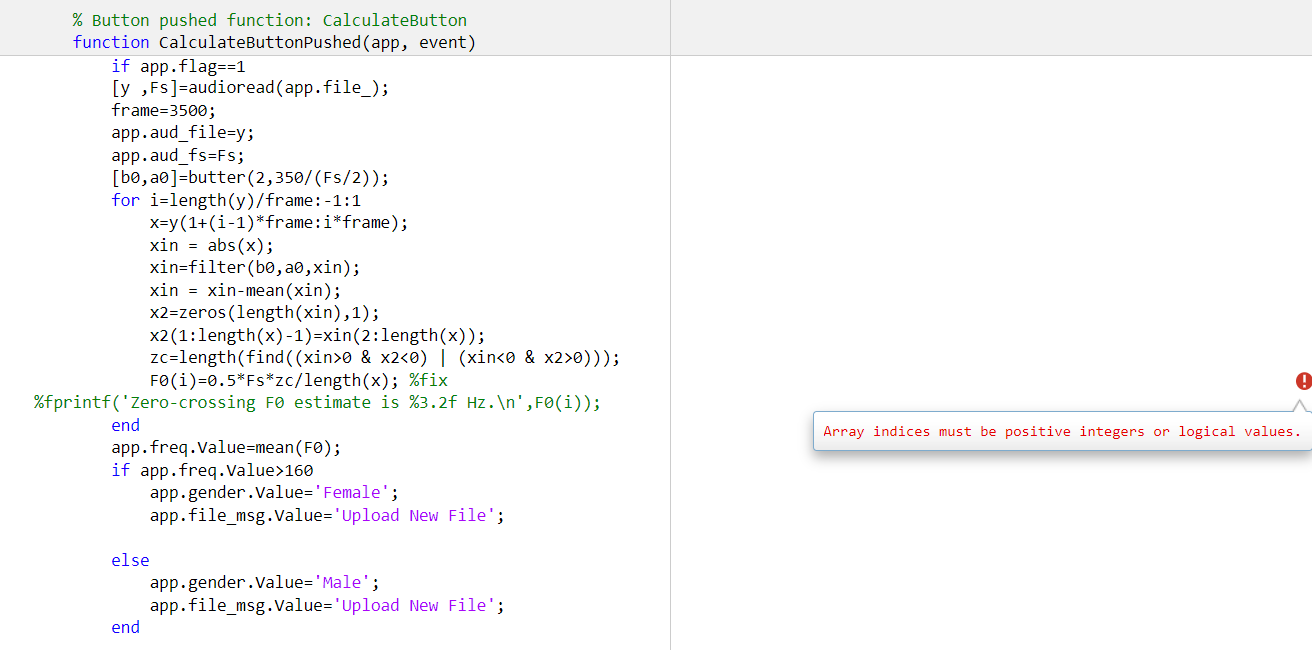
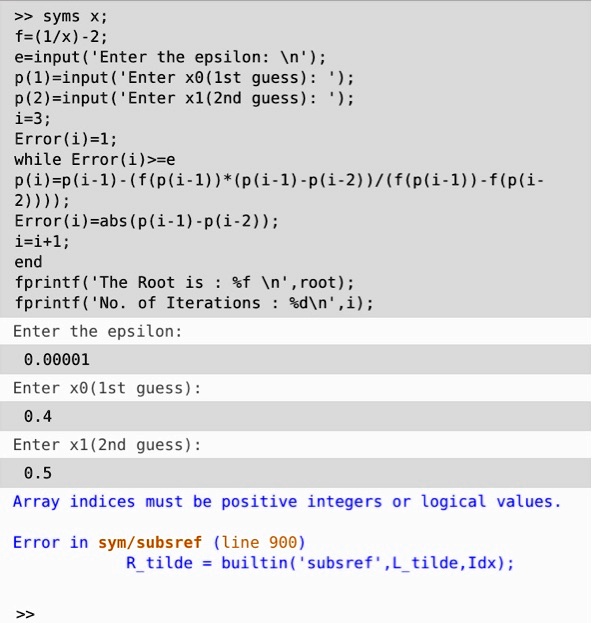











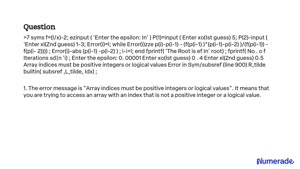



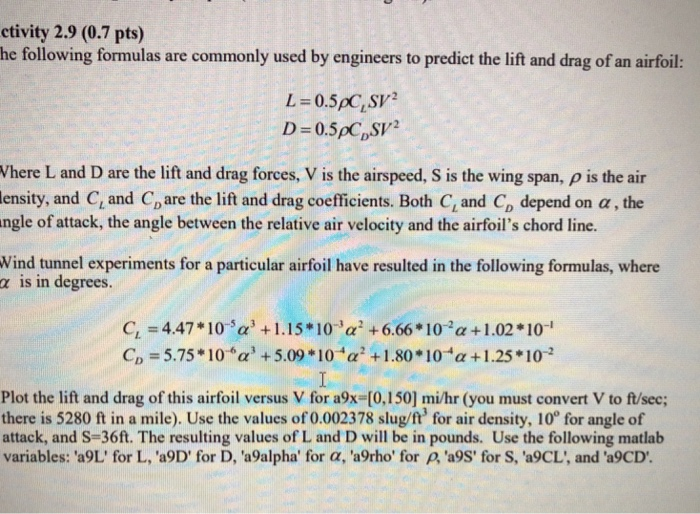






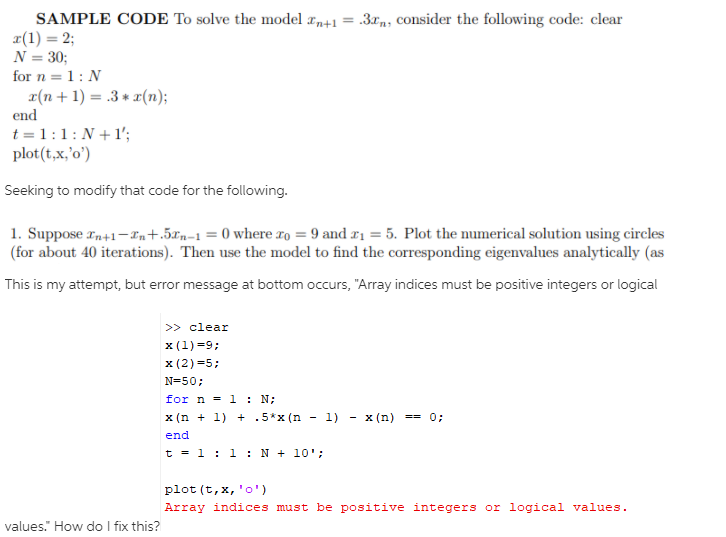

Article link: array indices must be positive integers or logical values.
Learn more about the topic array indices must be positive integers or logical values.
- Array indices must be positive integers or logical values
- 4.5: Indexing Errors – Engineering LibreTexts
- Array Indexing – MATLAB & Simulink – MathWorks
- Logical (Boolean) Operations – MATLAB & Simulink – MathWorks
- How do I fix an “Index exceeds the number of array elements (1)” error?
- 4.5: Indexing Errors – Engineering LibreTexts
- How to fix error “Array indices must be positive integers or …
- Array indices must be positive integers or logical values.
- in position 2 is invalid. Array indices must be positive integers …
- 0 ref PS selected, Array indices must be positive integers or …
- WHY DOES THIS GIVE ME “ARRAY INDICES MUST … – Chegg
See more: https://nhanvietluanvan.com/luat-hoc